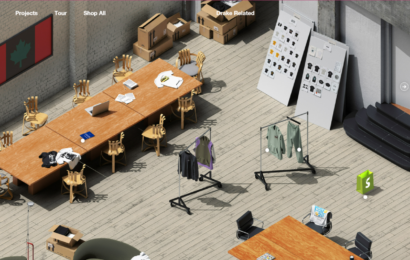If I were a writer then I would say “In a world bustling with economic activity, the term retail takes center stage, embodying an intricate dance between consumers and providers, products and experiences.”

The Players in the Retail Industry
If you analyze the retail ecosystem, you will find many different steps. Someone is working at every step and that is definitely important. I have divided the steps into 4 parts.
1. Manufacturers and Suppliers: The Architects of Innovation
They transform raw materials, concepts, and ingenuity into tangible goods that span a spectrum of industries, from fashion to electronics, from food to luxury.
2. Retailers: The Connectors of Dreams
Retailers curate, display, and market products with a keen understanding of consumer trends and desires, transforming the act of shopping into a sensory journey of discovery.
3. Distributors and Wholesalers: The Silent Facilitators
These intermediaries coordinate the flow of goods, streamline operations, and bridge the gap between manufacturers and retailers, ensuring that the retail landscape hums with vitality.
4. Consumers: The Heartbeat of the Retail Cycle
They select, purchase, and use products, and consumers catalyze the very essence of retail, imbuing it with a dynamic energy that propels the cycle forward.
Current Trends in Retail
Technology is constantly changing. Keeping pace with these changes, new trends are emerging in the retail business.
1. Digital and Physical Divide
Consumers now demand a seamless experience, transitioning effortlessly from browsing a mobile app to exploring an in-store display. This trend not only amplifies convenience but also deepens engagement, allowing retailers to craft a unified narrative that caters to diverse shopping preferences.
2. Data-Driven Insights
From product recommendations based on browsing history to customized promotions aligned with consumer preferences, data-driven insights enable retailers to speak directly to the hearts and minds of their audience. This trend creates a profound sense of connection, transforming the shopping journey into a curated adventure. For example, if you see any kind of ads related to dropshipping courses now, then there is nothing surprising.
3. Ethical Commerce
Conscious consumers are seeking out eco-friendly, cruelty-free, and ethically sourced products. Brands that champion responsible production, minimize waste, and embrace eco-conscious initiatives are resonating with an increasingly conscientious audience, fostering a sense of purpose-driven consumption.
The interplay between physical and online retail, like a dance of contrasts, has undergone a dramatic transformation in recent years, giving rise to a narrative of adaptation, innovation, and redefined shopping experiences. Let’s traverse this ever-shifting landscape and explore how these two realms are navigating the currents of change.
The Shifting Landscape of Physical vs Online Retail
1. Challenges Faced by Physical Stores
Traditional physical stores have long been the bastions of the retail world, providing tangible spaces for consumers to touch, feel, and experience products. However, these physical establishments have faced challenges in the digital age. The rise of online shopping and changing consumer behaviors have prompted physical stores to reimagine their role.
2. Concept Stores and Experiential Retail
As the tides of change swept through the retail landscape, the concept of physical stores evolved from mere product displays to immersive havens of experience. Concept stores have emerged as hubs of innovation, offering visitors unique and memorable interactions. These stores engage all senses, employing elements like innovative design, interactive displays, and in-store events to create an emotional connection with customers. In this way, physical retail has transitioned from being purely transactional to being transformational.
3. Pop-Up Shops and Temporary Retail
Intriguingly, temporary retail establishments, often referred to as pop-up shops, have emerged as a powerful tool in the arsenal of physical retailers. These transient spaces capture the essence of exclusivity and urgency, luring customers with the promise of limited-time offerings and one-of-a-kind experiences. By harnessing the power of scarcity and spontaneity, pop-up shops captivate attention, driving foot traffic and rekindling interest in the physical shopping experience.
4. Digital’s Resounding Impact: The Rise of Online Commerce
In parallel, the digital realm has reshaped the retail landscape by expanding the boundaries of access, convenience, and choice. Online commerce offers a virtual marketplace where consumers can explore an endless array of products, compare prices, and make purchases from the comfort of their screens. The growth of e-commerce giants and the proliferation of direct-to-consumer brands have disrupted traditional retail models, providing consumers with an unprecedented level of control and empowerment over their shopping journeys.
The Digital Frontier: E-commerce’s Impact
You know the rise of online marketplaces and the emergence of direct-to-consumer (DTC) brands have reshaped consumer behavior and challenged conventional notions of commerce. As we venture into the digital frontier, we unravel the profound impact of e-commerce on the retail ecosystem.
1. Growth of Online Marketplaces and Direct-to-Consumer Brands
In the realm of online marketplaces, what I truly appreciate is the flexibility of their return policies. I can make a purchase at my convenience without any upfront payment, only settling the bill upon the product’s arrival. If the item doesn’t meet my expectations, a simple return process awaits.
The beauty lies in the vast array of options available for my choosing, providing an almost limitless selection. This freedom empowers every customer to explore an online marketplace at their leisure, with no constraints on time. Furthermore, analyzing customer preferences becomes a seamless task, especially when it involves similar products.
Considering the landscape of retail, commencing a business without a website seems, frankly, nonsensical. It’s akin to missing out on a substantial opportunity.
2. Convenience, Accessibility, and the Impact on Traditional Retail Models
The 24/7 availability, coupled with seamless digital payment options, has redefined the shopping experience. Traditional retail models are adapting to this paradigm shift by enhancing their digital presence, offering click-and-collect services, and integrating online and offline experiences to provide consumers with the best of both worlds.
As I previously highlighted, present-day retail enterprises are actively striving to amplify their online visibility.
3. Last-Mile Delivery Innovations and the Importance of Efficient Logistics
The final stretch in the e-commerce journey, often referred to as the “last mile,” has emerged as a hub of innovation. Companies are pushing the envelope with cutting-edge delivery methods like drones and self-driving vehicles, aiming to expedite shipments and elevate customer satisfaction. The efficiency of this final phase plays a pivotal role in determining overall success, as any delays or hiccups could impact customer loyalty.
Pioneering solutions such as micro-fulfillment centers and local warehousing are designed to streamline the last-mile process. These approaches work towards reducing delivery times and minimizing the environmental footprint. A notable example is the remarkable work being done by organizations like Zipline, which employs drones to deliver vital medical supplies, reflecting how technology is reshaping traditional paradigms.
Considering the trajectory of internet evolution, one can’t help but speculate about the not-so-distant future where designated drone landing zones, akin to helipads, could facilitate personalized drone services directly to your doorstep. This innovative progression could reshape the landscape of home deliveries, making it conceivable for products to be whisked to your chosen location via drone.
The Future of Retail: Emerging Possibilities
Imagine pondering the future landscape of retail business. You’d likely anticipate a substantial integration of AI, and you’d be right on the money. AI is set to revolutionize the industry, enabling enhanced customer service, a deep understanding of consumer behavior, preferences, trends, and even intricate business analysis. With the power of AI, retail proprietors can swiftly make informed decisions, reaping the greatest advantages in demand projection, dynamic pricing, and efficient inventory management.
We’re well aware of the potential packed into a simple QR code. A quick scan can unveil a plethora of information about a product, spanning from its origins to its journey within the retail supply chain.
As mentioned earlier, Zipline’s deployment of drones for deliveries stands as a prime example of technological advancement. The era of robotic involvement in manufacturing is no longer a futuristic notion. It’s our present reality. A significant chunk of products now takes shape devoid of human touch. With the exception of the prospective retail entrepreneur, nearly every facet of the business is shifting toward automation. It’s an era where efficiency and innovation take center stage.
Adapting to Change: Strategies for Success
Drawing inspiration from evolutionary history, while the dinosaurs might have faded into the past, the resilient cockroach endured. However, my aim isn’t for your retail business to emulate the survival tactics of a cockroach. Instead, envision your enterprise as a colossal, dominating force akin to a dinosaur. So, what steps should you take?
Following our discussion on the Facebook Messenger app, you’ll notice a review section. In the pursuit of business survival, bolstering online visibility is a logical course of action. Yet, it’s equally vital to integrate a feedback mechanism. As visitors prepare to close their browsers, seize the opportunity to gather their insights. Amazon’s enduring success can be attributed to their unwavering commitment to customer satisfaction. Every piece of feedback is treated with utmost seriousness. Similar principles should guide your pricing and marketing endeavors.
In today’s landscape, I’ve observed numerous retail business social media pages with minimal activity. However, dismissing the potential of social media would be unwise. By actively engaging on these platforms, you can effortlessly attract a larger customer base than your competitors.
And don’t forget, diving into AI’s role in the retail domain holds promise. Acquiring proficiency in this realm could yield a satisfying return on investment. The path to success beckons with innovative strategies and embracing technological advancements.
Now
In this blog post, my attempt has been to delve into various facets of the retail business. If you find yourself harboring any questions on these matters, please don’t hesitate to drop a comment below. I assure you, I’ll be swift in responding to each and every comment.





